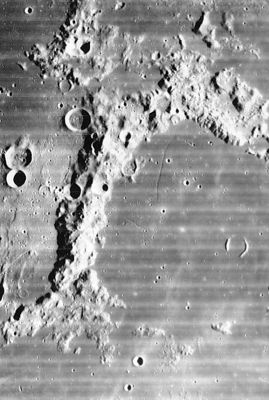Eddington
Contents
Eddington
(formerly Struve A)
|
Lat: 21.48°N, Long: 71.94°W, Diam: 120.13 km, Depth: 1.3 km, Rükl: 17 |
Images
LPOD Photo Gallery Lunar Orbiter Images Apollo Images
Zond 7 (Eddington and environs, evening light).
Maps
(LAC zone 37C2) USGS Digital Atlas PDF
Description
Elger
IAU Directions On the E. (of Otto Struve) is the much more regular and almost as large formation, Otto Struve A, the E. border of Otto Struve forming its W. wall. This enclosure is bounded elsewhere by a very low, broken, and attenuated barrier. At sunrise the W. and E. walls, with the mountain mass at the N. end, which they join, resemble a pair of partially-opened calipers. There is one conspicuous little crater on the E. side of the floor; and, at or near full moon, four or five white spots, nearly central, are prominently visible.
Wikipedia
Additional Information
- IAU page: Eddington
- Depth data from Kurt Fisher database
- Westfall, 2000: 1.3 km
- Cherrington, 1969: 1.31 km
- A wonderful example of the remains of a crater (Eddington P: the eastern and western sections of the rim, looking like arc-shaped hills; Two Arcs) is detectable on the floor of Eddington. There are several examples of this kind of formation on other parts of the moon. A survey to detect all of them would be a most interesting project! - DannyCaes Aug 4, 2014
- The appearance of the Two Arcs of Eddington P was also captured near the lower left corner of Lunar Orbiter 4's frame LO-IV-169-h3 (WARNING: High-Resolution scan!). - DannyCaes Aug 4, 2014
- There's a very similar formation (Two Arcs) at Rimae Hippalus (between Hippalus and Campanus), and also east of Gassendi, at LAT: -17.55, LON: -36.48 - DannyCaes Aug 5, 2014
Nomenclature
- Sir Arthur Stanley Eddington, OM (December 28, 1882 – November 22, 1944) was a British astrophysicist. The Eddington limit, the natural limit to the luminosity that can be radiated by accretion onto a compact object, is named in his honour. He is famous for his work regarding the Theory of Relativity. Eddington wrote an article in 1919, Report on the relativity theory of gravitation, which announced Einstein's theory of general relativity to the English-speaking world. Because of World War I, new developments in German science were not well known in England.
- The name "Eddington" was originally applied to a different crater by Cameron and WIlkins, but not accepted by the IAU. The name was added to the IAU Nomenclature in 1964 as a result of its adoption of the System of Lunar Craters. Before that, this feature was officially known as "O. Struve A". "Otto Struve" in Elger is a reference to the parent crater now known as Struve (Whitaker, 1999, p235).
- Eddington Alpha (hill in the southern part of Eddington's ruined rim) (see chart SLC F3) (System of Lunar Craters, 1966).
LROC Articles
LPOD Articles
Bibliography
Eddington in the Sourcebook Project (William R. Corliss)
Something to investigate...
A certain Eddington is mentioned in the article On the Observations of the Reported Dusky Ring outside the Bright Rings of the Planet Saturn (Richard M. Baum, Journal of the British Astronomical Association, 1954), see page 466 in Mysterious Universe, a handbook of astronomical anomalies (William R. Corliss, The Sourcebook Project, 1979). Note: this article is most interesting for telescopic observers of the moon who study planetary occultations and possible apparitions of a faint glow preceding or following an occultation of a bright planet, for example, Saturn (shortly before the appearance or shortly after the disappearance of the planet itself at the dark limb of the moon).- DannyCaes Mar 29, 2015
Another Eddington is mentioned on page 670 in the article Aether Drift Detected At Last (Michael Rowan-Robinson, Nature, 1977), and A.S.Eddington on page 674 in the article The Einstein Shift - an unsettled problem (F.Schmeidler, Sky and Telescope, 1964). Sir Arthur Eddington is mentioned on page 692 (The Velocity of Light, M.E.J.Gheury de Bray, Nature, 1934). - DannyCaes Apr 26, 2015Note: the last three Eddingtons are probably one and the same Arthur Stanley Eddington...
Named Features -- Prev: Eckert -- Next: Edison
